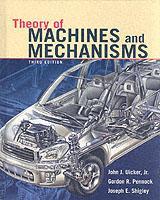Theory of machines and mechanisms, (3rd Ed.)
Langue : Anglais
Auteurs : UICKER John J., PENNOCK Gordon R.

This textbook covers the design of mechanisms, kinematics and dynamics of machines. The book is intended for senior/grad students (4th /5th year) in mechanical engineering who are taking a course commonly called Kinematics, or the Design of Machine Elements. It includes a balanced coverage of all topics by both graphic and analytic methods and covers all major analytic approaches.
Preface, Part. Kinematics and Mechanisms,. The World of Mechanisms, 1.1: Introduction, 1.2: Analysis and Synthesis, 1.3: The Science of Mechanics, 1.4: Terminology, Definitions, and Assumptions, 1.5: Planar, Spherical, and Spatial Mechanisms, 1.6: Mobility, 1.7: Classification of Mechanisms, 1.8: Kinematic Inversion, 1.9: Grashof's Law, 1.10: Mechanical Advantage, 1.11: Problems,. Position and Displacement, 2.1: Locus of a Moving Point, 2.2: Position of a Point, 2.3: Position Difference between Two Points, 2.4: Apparent Position of a Point, 2.5: Absolute Position of a Point, 2.6: The Loop-Closure Equation, 2.7: Graphic Position Analysis, 2.8: Algebraic Position Analysis, 2.9: Complex-Algebra Solutions of Planar Vector Equations, 2.10: Complex Polar Algebra, 2.11: Position Analysis Techniques, 2.12: The Chace Solutions to Planar Vector Equations, 2.13: Coupler Curve Generation, 2.14: Displacement of a Moving Point, 2.15: Displacement Difference between Two Points, 2.16: Rotation and Translation, 2.17: Apparent Displacement, 2.18: Absolute Displacement, 2.19: Problems,. Velocity, 3.1: Definition of Velocity, 3.2: Rotation of a Rigid Body, 3.3: Velocity Difference between Points of a Rigid Body, 3.4: Geometric Methods, Velocity Polygons, 3.5: Apparent Velocity of a Point in a Moving Coordinate System, 3.6: Apparent Angular Velocity, 3.7: Direct Contact and Rolling Contact, 3.8: Systematic Strategy for Velocity Analysis, 3.9: Analytic Methods, 3.10: Complex-Algebra Methods, 3.11: The Method of Kinematic Coefficients, 3.12: The Vector Method, 3.13: Instantaneous Center of Velocity, 3.14: The Aronhold-Kennedy Theorem of Three Centers, 3.15: Locating Instant Centers of Velocity, 3.16: Velocity Analysis Using Instant Centers, 3.17: The Angular-Velocity-Ratio Theorem, 3.18: Relationships between First-Order Kinematic Coefficients and Instant Centers, 3.19: Freudenstein's Theorem, 3.20: Indices of Merit, Mechanical Advantage, 3.21: Centrodes, 3.22: Problems,. Acceleration, 4.1: Definition of Acceleration, 4.2: Angular Acceleration, 4.3: Acceleration Difference between Points of a Rigid Body, 4.4: Acceleration Polygons, 4.5: Apparent Acceleration of a Point in a Moving Coordinate System, 4.6: Apparent Angular Acceleration, 4.7: Direct Contact and Rolling Contact, 4.8: Systematic Strategy for Acceleration Analysis, 4.9: Analytic Methods, 4.10: Complex-Algebra Methods, 4.11: The Method of Kinematic Coefficients, 4.12: The Chace Solutions, 4.13: The Instant Center of Acceleration, 4.14: The Euler-Savary Equation, 4.15: The Bobillier Constructions, 4.16: Radius of Curvature of a Point Trajectory Using Kinematic Coefficients, 4.17: The Cubic of Stationary Curvature, 4.18: Problems, Part. Design of Mechanisms,. Cam Design, 5.1: Introduction, 5.2: Classification of Cams and Followers, 5.3: Displacement Diagrams, 5.4: Graphical Layout of Cam Profiles, 5.5: Kinematic Coefficients of the Follower Motion, 5.6: High-Speed Cams, 5.7: Standard Cam Motions, 5.8: Matching Derivatives of the Displacement Diagrams, 5.9: Plate Cam with Reciprocating Flat-Face Follower, 5.10: Plate Cam with Reciprocating Roller Follower, 5.11: Problems,. Spur Gears, 6.1: Terminology and Definitions, 6.2: Fundamental Law of Toothed Gearing, 6.3: Involute Properties, 6.4: Interchangeable Gears, AGMA Standards, 6.5: Fundamentals of Gear-Tooth Action, 6.6: The Manufacture of Gear Teeth, 6.7: Interference and Undercutting, 6.8: Contact Ratio, 6.9: Varying the Center Distance, 6.10: Involutometry, 6.11: Nonstandard Gear Teeth, 6.12: Problems7. Helical Gears, 7.1: Parallel-Axis Helical Gears, 7.2: Helical Gear Tooth Relations, 7.3: Helical Gear Tooth Proportions, 7.4: Contact of Helical Gear Teeth, 7.5: Replacing Spur Gears With Helical Gears, 7.6: Herringbone Gears, 7.7: Crossed-Axis Helical Gears, 7.8: Problems8. Bevel Gears, 8.1: Straight-Tooth Bevel Gears, 8.2: Tooth Proportions for Bevel Gears, 8.3: Crown and Face Gears, 8.4: Spiral Bevel Gears, 8.5: Hypoid Gears, 8.6: Problems,. Worms and Worm Gears, 9.1: Basics, 9.2: Problems,. Mechanism Trains, 10.1: Parallel-Axis Gear Trains, 10.2: Examples of Gear Trains, 10.3: Determining Tooth Numbers, 10.4: Epicyclic Gear Trains, 10.5: Bevel Gear Epicyclic Trains, 10.6: Analysis of Planetary Gear Trains by Formula, 10.7: Tabular Analysis of Planetary Gear Trains, 10.8: Adders and Differentials, 10.9: All Wheel Drive Train, 10.10: Problems,. Synthesis of Linkages, 11.1: Type, Number, and Dimensional Synthesis, 11.2: Function Generation, Path Generation, and Body Guidance, 11.3: Two-Position Synthesis of Slider-Crank Mechanisms, 11.4: Two-Position Synthesis of Crank-and-Rocker Mechanisms, 11.5: Crank-Rocker Mechanisms with Optimum Transmission Angle, 11.6: Three-Position Synthesis, 11.7: Four-Position Synthesis, Point-Precision Reduction, 11.8: Precision Positions, Structural Error, Chebychev Spacing, 11.9: The Overlay Method, 11.10: Coupler-Curve Synthesis, 11.11: Cognate Linkages, The Roberts-Chebychev Theorem, 11.12: Bloch's Method of Synthesis, 11.13: Freudenstein's Equation, 11.14: Analytic Synthesis Using Complex Algebra, 11.15: Synthesis of Dwell Mechanisms, 11.16: Intermittent Rotary Motion, 11.17: Problems,. Spatial Mechanisms, 12.1: Introduction, 12.2: Exceptions in the Mobility of Mechanisms, 12.3: The Position-Analysis Problem, 12.4: Velocity and Acceleration Analyses, 12.5: The Eulerian Angles, 12.6: The Denavit-Hartenberg Parameters, 12.7: Transformation-Matrix Position Analysis, 12.8: Matrix Velocity and Acceleration Analyses, 12.9: Generalized Mechanism Analysis Computer Programs, 12.10: Problems,. Robotics, 13.1: Introduction, 13.2: Topological Arrangements of Robotic Arms, 13.3: Forward Kinematics, 13.4: Inverse Position Analysis, 13.5: Inverse Velocity and Acceleration Analyses, 13.6: Robot Actuator Force Analyses, 13.7: Problems, Part. Dynamics of Machines,. Static Force Analysis, 14.1: Introduction, 14.2: Newton's Laws, 14.3: Systems of Units, 14.4: Applied and Constraint Forces, 14.5: Free-Body Diagrams, 14.6: Conditions for Equilibrium, 14.7: Two- and Three-Force Members, 14.8: Four-Force Members, 14.9: Friction-Force Models, 14.10: Static Force Analysis with Friction, 14.11: Spur- and Helical-Gear Force Analysis, 14.12: Straight-Bevel-Gear Force Analysis, 14.13: The Method of Virtual Work, 14.14: Problems,. Dynamic Force Analysis (Planar), 15.1: Introduction, 15.2:
Date de parution : 01-2003
Ouvrage de 880 p.
23x18 cm
Thèmes de Theory of machines and mechanisms, :
© 2024 LAVOISIER S.A.S.
